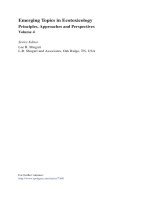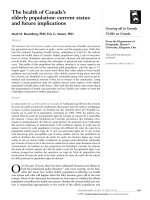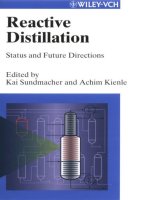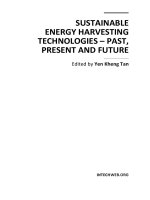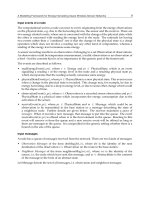Oxo-biodegradable Polymers Present Status and Future Perspectives
Bạn đang xem bản rút gọn của tài liệu. Xem và tải ngay bản đầy đủ của tài liệu tại đây (190.34 KB, 27 trang )
379
Oxo - biodegradable Polymers: Present Status and
Future Perspectives
Emo Chiellini , Andrea Corti , Salvatore D ’ Antone , and David McKeen Wiles
16.1
Introduction
Synthetic and semisynthetic polymeric materials were developed for their versatil-
ity, easy processability, and durability – resistance to all forms of degradation as
promoted by physical, chemical, and biological means or combinations thereof.
Enhanced durability is achieved when required by including stabilizing additives
(usually in combinations) and by processing under conditions that maximize the
maintenance of molecular weight and functionality during fabrication and under
subsequent service conditions. Macromolecular materials have been and are
widely accepted because of their cost - effectiveness to provide a large variety of
items that improve the comfort and quality of life in both modern industrial socie-
ties and developing countries. Moreover, the demand in the next two decades for
polymeric materials is expected to increase two - to threefold primarily as a conse-
quence of an increase in plastics consumption in developing countries, with an
annual growth rate worldwide of 7 – 10%.
Plastics are ubiquitous because the various types that are commercially available
collectively span a very wide range of useful properties. It is commonly claimed
that approximately one - third of all commodity plastics are used for packaging
purposes. The reason is that these materials are inexpensive, easy to fabricate,
strong, tough, stretchy, have good barrier properties, and are reusable and recy-
clable, among other characteristics. The polyethylene ( PE ) shopping bag is an
example of a common plastic article that is used in very large quantities because
it does exactly what it is supposed to do at very low cost. It has supplanted the
alternatives, for example, the brown paper bag, almost completely at checkout
stations because it has overall superior properties and, most importantly, it is
much less of an environmental burden to produce and transport [1, 2] . One criti-
cism that is leveled at commodity plastics in short - lived applications, however, is
that they persist too long after they are used and discarded. This is considered to
lead to a serious plastic waste burden. The banning or taxing of PE shopping
bags and analogous products is not the answer, however, because consumer
Handbook of Biodegradable Polymers: Synthesis, Characterization and Applications, First Edition. Edited by
Andreas Lendlein, Adam Sisson.
© 2011 Wiley-VCH Verlag GmbH & Co. KGaA. Published 2011 by Wiley-VCH Verlag GmbH & Co. KGaA.
16
380
16 Oxo-biodegradable Polymers
requirements need to be met and there is no acceptable substitute. Therefore,
innovative technology is required.
The design, production, and consumption of polymeric materials for commod-
ity and specialty plastic items must surely contend with all the constraints and
regulations already in place or predicted to deal with the management of primary
and postconsumer plastic waste. This is certain to involve the formulation of
environmentally sound degradable polymers. Technologies based on the recovery
of free energy content through recycling and from incineration with heat recovery
will be fl anked by the increasingly attractive option of environmentally degradable
macromolecular materials. These latter polymers should be considered as pre-
ferred replacements for conventional commodity plastics in those product seg-
ments for which recycling is not a practical option. The strategies that are
nowadays receiving a great deal of attention at both fundamental and applied
levels include the design of some bio - based polymers, the introduction of hybrid
polymeric formulations, and the reengineering of well - established polymers of
synthetic and natural origin.
16.2
Controlled – Lifetime Plastics
During the past 20 years, science and technology have been developed for poly-
mers that can biodegrade after being used and discarded. Everything from shop-
ping bags to agricultural mulch fi lms to daily landfi ll covers to food packaging as
examples can be made to disintegrate after disposal and to yield thereby molecular
fragments that are susceptible to mineralization by naturally occurring microor-
ganisms. The carbon in these polymers is returned to the biocycle, and there are
no harmful residues. These are the oxo - biodegradable polyolefi ns, as defi ned
below.
According to the ASTM defi nition [3] , a biodegradable plastic is “ a degradable
plastic in which the degradation results from the action of naturally occurring microor-
ganisms such as bacteria, fungi and algae. ” Rather more informative is the ASTM
defi nition [4] of the environmental degradation of a plastic: “ abiotic or biotic degra-
dation process or both that occurs in a given environment and includes photodegrada-
tion, oxidation, hydrolysis and biodegradation. Living organisms affect biotic degradation
processes and abiotic degradation processes are not biological in nature. ” Two principal
types of commercially viable biodegradable plastics have been developed and are
fi nding a variety of applications in many mercantile segments and consumer
products: (i) oxo - biodegradable polymers for which degradation is the result of oxida-
tive and cell - mediated phenomena, either simultaneously or successively and (ii)
hydro - biodegradable polymers for which degradation is the result of hydrolytic and
cell - mediated phenomena, either simultaneously or successively. Both types of
biodegradable polymer feature a two - stage sequential molar mass reduction in the
environment with the fi rst stage being abiotic. Since the objective is to reduce the
amount of plastic with minimum effect on the environment, the second stage is
16.2 Controlled – Lifetime Plastics
381
bioassimilation of the molecular fragments that are generated in the fi rst stage.
Abiotic mechanisms are generally regarded as too slow by themselves to be ade-
quate in a variety of disposal environments.
There are several applications in which really quite rapid degradation of plastics
after use is required. For example, plastics that end up in water - or sewage -
treatment systems are an example of situations in which they need to lose integrity
relatively rapidly so as to avoid plugging pumps, fi lters and the like. Hydrolytically
unstable biodegradable plastics can provide an answer here. In many other uses
(e.g., food packaging), however, hydrolytic instability is a disadvantage. Overall
stability is required during shelf storage and use, but this should be followed by
relatively rapid abiotic degradation within a specifi c time, depending on the dis-
posal environment. The avoidance of the accumulation of plastic fragments
requires that these be consumed through biodegradation by microorganisms in
virtually all disposal environments. Effective biodegradation of such residues can
be achieved when originally hydrophobic plastics acquire water - wettable
(hydrophilic) surfaces and a relatively low molecular weight so that there is a
signifi cant number of molecular “ ends ” accessible at the surface. The science and
technology of the development of commercially viable commodity plastics that can
meet these criteria are the topics addressed in this chapter.
Of the current worldwide production of synthetic polymers, nearly 90% is rep-
resented by full - carbon - backbone macromolecular systems (polyvinyl and polyvi-
nylidenics [5] ), and 35% to 45% of production is for one - time use items (disposables
and packaging).Therefore, it is reasonable to envisage a dramatic environmental
impact attributable to the accumulation of plastic litter and other plastic waste
from discarded full - carbon - backbone polymers, which are conventionally recalci-
trant to physical, chemical, and biological degradation processes. The mechanism
of biodegradation of full - carbon - backbone polymers requires an initial oxidation
step, mediated or not by enzymes, followed by fragmentation with a substantial
reduction in molecular weight. The functional fragments then become vulnerable
to microorganisms present in different environments, with production (under
aerobic conditions) of carbon dioxide, water and cell biomass. Figure 16.1 outlines
the general features of environmentally degradable polymeric materials, which are
classifi ed as hydro - biodegradable and oxo - biodegradable. Typical examples of
oxo - biodegradable polymers are PE, poly(vinyl alcohol) [6] , natural rubber (poly -
cis - 1,4 isoprene) [7] , and lignin, a naturally occurring structurally complex
heteropolymer.
The prodegradant added to polyolefi ns to convert them to oxo - biodegradable
status does not cause any oxidation or other degradation as long as antioxidants
are present. Thus, the shelf life and use life of the plastics are maintained for a
period that is controlled by the amount of antioxidant (or other stabilizing addi-
tives) present in the formulation. Once the stabilizers have been depleted, the
prodegradant catalyses the oxidative degradation of the polymer, with the rate of
degradation related to the concentration of prodegradant. By controlling the con-
centrations of these two classes of additive, one practically controls the “ lifetime ”
of the plastic.
382
16 Oxo-biodegradable Polymers
16.3
The Abiotic Oxidation of Polyolefi ns
The knowledge [8 – 10] of the thermal and photolytic peroxidation mechanisms of
PE and polypropylene ( PP ) constitutes the basis for the development of “ reengi-
neered ” polyolefi ns susceptible to enhanced oxidation and fragmentation, when
exposed to heat or light, with the aim of overcoming the intrinsic recalcitrance of
polyolefi ns to biodegradation. It has been established that the beginning of the
sequence of reactions leading to polyolefi n peroxidation is the generation of sen-
sitizing impurities during the processing of these thermoplastics [8] . It has been
recognized that carbonyl [8, 11] and hydroperoxide [8, 12, 13] groups represent the
major sensitizing impurities formed during the processing of PE and of PP. At
this stage, the chemical structure of the polyolefi ns is considered to be the most
important parameter capable of infl uencing the oxidative degradation processes.
During subsequent use and disposal steps, the oxidation of both types of resin
appears to be mainly affected by structural parameters, such as the degree of
polymerization, chain conformation, degree of crystallinity, and geometry [13] .
In the case of PE, the poor reactivity of the nonpolar C – C and C – H bonds mark-
edly constrains the degradation processes by radical reactions. These are generally
initiated by bond - breaking processes promoted by energy input in the form of
heat, UV radiation, mechanical stress, or some combination of these. Since the
susceptibility of saturated bonds to scission is dependent on bond energy, the
initial homolytic bond scission reactions are largely restricted to structural defects,
such as branch points and double bonds. The tertiary carbon – hydrogen bonds that
alternate with methylene groups along PP chains are obviously vulnerable. Fol-
lowing initial bond breakage, a complex series of radical reactions may lead to the
total degradation of the molecules.
Figure 16.1
General features of the two classes of environmentally degradable polymers.
• Hydro-Biodegradable • Oxo-Biodegradable
• Functional Fragments • Oxidized Fragments
• CO
2
, H
2
O, Cell Biomass • CO
2
, H
2
O, Cell Biomass
H
2
O - Uptake
Enzyme mediated
or not
O
2
- Uptake
Catalyst
natural or
synthetic
Exo-Endo
Enzymes
Exo-Endo
Enzymes
• Polyesters
• Polymaides
• Polysaccharides
• Polyolefins
• Polyvinylalcohol
Lignin, Rubber
• Natural rubber
16.3 The Abiotic Oxidation of Polyolefi ns
383
16.3.1
Mechanisms
The overall sequence of reactions that are the basis of PE oxidation and of poly-
olefi ns in general has been elucidated during several decades of research, produc-
ing a large number of original papers and review articles. For example, it is widely
accepted that the starting point of the process is the homolytic cleavage of C – C
bonds in the backbone that occurs during polymer processing as a result of shear
stresses during extrusion [14] . In the presence of oxygen (as in most industrial
processes), the carbon - centered radicals are converted to peroxy radicals, and then
to hydroperoxides by hydrogen abstraction from nearby tertiary sites. The high
reactivity of hydroperoxides subjected to heat and/or UV light promotes a further
series of reactions leading to chain scission (molar mass reduction) and the forma-
tion of several different oxidized groups. In the overall peroxidation process of PE,
the decomposition of hydroperoxide groups is acknowledged to be the rate -
determining step [13] . This initiates a radical chain reaction which is autoaccelerat-
ing, as shown in Scheme 16.1 .
Even though the aim of this chapter is not to review the large amount of litera-
ture on polyolefi n degradation, a general overview of the mechanism and kinetics
of PE oxidation is useful for a better understanding of the environmental fate of
PE. In this connection, the basic mechanism proposed by Bolland and Gee
[15] – comprising the classic steps of initiation, chain propagation, and termina-
tion – should be considered as relevant (Scheme 16.1 ). As already mentioned, the
key intermediates in the accepted mechanism are hydroperoxides, the decomposi-
tion of which produces further free radicals and the derived oxidation products.
Many of the kinetic studies of thermooxidative processes of polyolefi ns are for
polymers in the melt, and several mechanistic studies have focused on polymers
in a solution. Considering that the practical uses of polyolefi ns are in the solid
state, numerous studies have been devoted to the investigation of the kinetics of
the thermal and photooxidation of polyolefi n fi lms and sheets. Oxidation products
Scheme 16.1
General mechanism of peroxidation and chain cleavage in polyolefi ns.
[L
3
,(RCOO)
3
Me
III
]
hv
–CH
2
–CH
2
–CH
2
–
[L
4
,(RCOO)
2
Me
II
] + RCOO • R
•
+ CO
2
R
•
–CH
2
–CH–CH
2
–
•
+ O
2
–CH
2
–CH–CH
2
–
OO
•
–
–CH
2
–CH–CH
2
–
OOH
–
–CH
2
–C–O–CH
2
–
O
=
–CH
2
–C–CH
3
O
=
–CH=CH
2
–CH
2
–COOH + + +
–CH
2
–C–O–CH
2
–
O
=
–CH
2
–COOH
–CH
2
–CH–CH
2
–
OOH
–
–CH
2
–CH–CH
2
–+
OOH
–
+ PH P
•
–CH
2
–CH–CH
2
–
OO
•
–
hv + O
2
∆ + O
2
384
16 Oxo-biodegradable Polymers
have been identifi ed and several parameters, such as oxygen pressure, tempera-
ture, and sample thickness that infl uence oxidation processes have been consid-
ered in the investigations.
16.3.2
Oxidation Products
Fourier transform infrared ( FTIR ) spectroscopy is one of the most powerful tech-
niques to be used in studying the kinetics of PE and PP oxidation in the solid state.
Signifi cant changes can be easily monitored in various regions of the spectra of
fi lms and sheets during thermal and photooxidation. In particular, the presence
of hydroperoxides is recognized from absorption bands between 3400 and
3200 cm
− 1
and absorptions in the carbonyl region – specifi cally between 1780 and
1700 cm
− 1
– are used to evaluate the rate and extent of the oxidative degradation of
polyolefi ns. In addition, the absorbance variation of double - bond deformation
peaks as well as the absorption from carbon – oxygen single bonds can provide
valuable information on the mechanism and oxidation products involved.
When oxygen concentrations are nonlimiting, during the initiation stage, it may
be assumed that all the macroradicals as they are produced (e.g., by shear stresses)
are instantly oxidized to peroxy radicals which, by intra - or intermolecular abstrac-
tion, are then converted to hydroperoxides. A fairly complex series of chain reac-
tions involving the formation/decomposition of peroxy radicals/hydroperoxides
constitutes the propagation step leading to oxidation product formation and chain
scissions. It has been estimated that, in oxidized solid PE, more than 80% of the
oxygen - containing products are represented by carbon chains bearing ketone or
carbonyl groups [13] . Briefl y their formation is generally attributed to the decom-
position of hydroperoxides (in the case of ketones), whereas carbonyl groups are
considered to be produced by peroxide decomposition. In addition, the conversion
of alkoxy macroradicals by β - scission to produce a carbonyl group and a chain - end
radical can occur. It has been ascertained that there is a straightforward relation-
ship between the number of carbonyl groups formed and the extent of chain
scission. Thus quantitative FTIR analysis can be used effectively to measure the
extent of the abiotic thermal degradation of PE [16] .
As a consequence of the radical oxidation processes and relevant chain scissions,
a fairly high number of degradation products containing functional groups have
been recognized in several investigations. In particular, two different classes rep-
resented by low - medium molecular weight fractions and volatile intermediates,
respectively, can be detected during kinetic studies of the thermal and photooxida-
tion of PE. As a result, the oxidation processes of PE and in particular of low -
density polyethylene ( LDPE ) can be monitored effectively by gravimetric analysis
showing the weight increase (oxygen uptake) as a function of the thermal aging
time and temperature [16] . In a case study, carried out on an LDPE sample con-
taining a thermal prodegradant, the time profi le of weight variation showed a
S - shaped profi le, thus accounting for the exponential accumulation of oxidized
low - medium molecular weight fractions, followed by the progressive weight
16.3 The Abiotic Oxidation of Polyolefi ns
385
decrease owing to the loss of volatile intermediates. In several studies, low - medium
molecular weight products containing carbonyl and hydroxyl groups have been
identifi ed [17] . It has been ascertained also that the amounts of these products
account for at least 80% of the products containing ketone and carboxyl groups
[13] . Carboxylic acids tend to accumulate during prolonged exposure times since
other oxygen - containing products formed in the early stages of the degradation
process, such as alcohols, aldehydes, and ketones, are susceptible to further oxida-
tion to produce carboxylic acids. In classic studies [18, 19] , most of the low -
molecular - weight degradation products from both thermally - and photooxidized
PE have been isolated and identifi ed by solid - phase extraction coupled with gas
chromatography/mass spectrometry. Accordingly, numerous semivolatile com-
pounds have been identifi ed [17] including alkanes, alkenes, ketones, aldehydes,
alcohols, mono - and di - carboxylic acids, lactones, keto - acids, and esters. In addi-
tion, highly volatile organic products (C2 – C6) have also been detected although in
a very relatively small amounts. Among these, acetaldehyde represents the most
important; its quantitative release profi le has been monitored [13] .
As discussed above, carboxylic and dicarboxylic acids have been found to be the
most abundant products which are formed during both photo - and thermal oxida-
tion. They tend to accumulate owing to their low propensity to oxidize further
during prolonged aging. They presumably evolve from the oxidation of other
functional groups, such as primary alcohols and aldehydes deriving from hydroper-
oxide decomposition followed by hydrogen abstraction or β - scission, respectively,
particularly during thermal aging. Also, the photolytic cleavage of ketone groups
by Norrish mechanisms can lead to the formation of carboxylic acid groups.
Accordingly, dicarboxylic acids have been found to be the predominant products
formed during the prolonged photoxidation of PE [20] . The presence of large
amounts of carboxylic acids, as demonstrated qualitatively by FTIR spectroscopy,
suggests the severe alteration of the PE matrix. Indeed, with the progressive accu-
mulation of carboxylic groups as a function of exposure time, there is an accom-
panying variation in both the shape and the intensity of the absorption bands
between 3800 and 3400 cm
− 1
that are associated with aliphatic carboxylic acids.
Owing to their relative thermal stability (compared to photoinstability), ketone
groups are considered as typically associated with the thermal degradation of PE.
Other products, recognizable in the volatile and semivolatile fractions of PE oxida-
tion products, such as keto - acids, have been identifi ed during low - temperature
thermal degradation, whereas lactones are usually generated under extreme condi-
tions or after extensive degradation has occurred [18, 19, 21] .
Since most of the oxidation products result in the fi rst instance from the decom-
position of polymer hydroperoxides, they are formed and trapped within the bulk
solid, and only a small fraction can escape. In this connection, it has been noted
that the estimation of the degradation products extractable with organic solvent(s)
should both provide useful information about the level of oxidative degradation
and help characterize the low - medium - molecular - weight oxidation products.
Further information about the regioselectivity of oxidation can be obtained by
analyzing the level of solvent extractable fractions and molecular weight and
386
16 Oxo-biodegradable Polymers
polydispersity of a nonextractable polymer residue. The characterization of the
oxidized fraction of PE soluble in a dichlorobenzene – methanol mixture showed
that it contained a large amount of oxygen - containing functional groups attached
to low - molecular - weight chain fragments, whereas the nonextractable portion of
the polymer contained a relatively low level of oxidation [13] .
16.3.3
Prodegradant Effects
In a recent study of ours [16] the amount of extractable fraction from thermally
oxidized LDPE samples containing prodegradant additives was evaluated as a
function of the level of polymer matrix oxidation as assessed by the carbonyl index
( CO i ) (Figure 16.2 ). In particular, it was shown that the amount of acetone -
extractable material is positively correlated to the level of oxidation induced by
thermal treatment in an oven, thus reaching fairly high levels corresponding to
25 – 30% of the original sample weight. The solvent - extractable fractions, as char-
acterized by NMR and by FTIR, were heavily oxidized and had low molecular
weights (0.80 – 1.60 kDa). Furthermore, it was also observed that the increase in
oxidation level as related to CO i values was matched by an increase in the quantity
of oxidized plastic having reduced molecular weight.
The large amount of numerous oxidation products, as well as their relative
concentrations, are accounted for by the large number of interrelating elementary
reactions, and these give rise to a rather complex scheme to describe the oxidation
kinetics. In spite of the major interest in these complex series of chain reactions
that has attracted a great deal of attention over the past 50 years, little agreement
on the kinetic models and values of specifi c rate constants has been achieved, from
either a theoretical or an experimental basis. One of the more contentious issues
is that of whether the oxidation mechanism should be considered as a homogene-
Figure 16.2
Percentage of fractions extractable with acetone and relevant molecular weight in
thermally treated LDPE fi lm at various levels of oxidation as determined by the carbonyl index
(CO i ).
30
25
20
15
10
5
0
COi 0.63 COi 2.24
1.49 kD
1.08 kD
1.06 kD
0.89 kD
COi 4.82 COi 5.44
Extract (%) Mw Extract (kD)
16.4 Enhanced Oxo-biodegradation of Polyolefi ns
387
ous phenomenon or as a heterogeneous process involving the spread of degrada-
tion from localized centers. This latter interpretation takes into account the
semicrystalline nature of polyolefi ns, where amorphous regions, more susceptible
to oxygen diffusion and oxidation, coexist with crystalline regions where oxidation
events are hindered, largely owing to the negligible dissolved oxygen content.
Even though the aim of this chapter is not to review this topic, some basic sim-
plifi ed information on kinetic oxidation processes is useful to predict the ultimate
oxo - biodegradation propensity of PE. In particular, the effect of physical parame-
ters such as aging time, temperature, and radiation intensity may affect the sub-
sequent extensive biodegradation step. Indeed, one of the most important
requirements, in order to predict the oxidative behavior of polyolefi n fi lms, is the
correlation between the experimental kinetics of oxidation and the chemical reac-
tions that may occur in the bulk polymer. In several studies, therefore, it has been
shown that the early stage of the thermooxidative degradation of PE, as monitored
by the formation of carbonyl groups, is apparently in agreement with a typical
auto - acceleration mechanism [22] . In the overall peroxidation of PE, the decom-
position of hydroperoxide groups is therefore considered to be the rate - determining
step [13] . Hence, additive molecules which are capable of enhancing hydroperoxide
formation and decomposition to other radicals are active prodegradants since they
accelerate the oxidation and cleavage of polyolefi n chains.
16.4
Enhanced Oxo - biodegradation of Polyolefi ns
Major strategies to enhance the environmental degradation and biodegradation of
polyolefi ns have been focused on copolymerization, blending, or grafting with
functional polymers and other compounds as well as the addition of prodegradant
additives. UV - absorbing carbonyl groups capable of accelerating the photooxida-
tion process can be introduced by copolymerizing ethylene and carbon monoxide
or vinyl ketones [23 – 26] , the latter strategy being the technical process used in the
production of Ecolyte polyolefi ns [25] . Another strategy to improve the environ-
mental degradability of PE and PP fi lms is the addition of prodegradant additives
during processing [27] . It has been suggested, in fact, that this latter alternative
may provide a more effi cient control of the degradation rate, thus making the shelf
life and use life of the polyolefi ns compatible with a very wide range of applications
and disposal environments [14] . Most of the prodegradant additives used com-
mercially are organic complexes of transition metals, those capable of yielding two
metal ions differing in oxidation number by one unit. Several polymer - soluble
metal carboxylates and acetylacetonates of Co
3 +
, Fe
3 +
, and Mn
2 +
are very effective
photoprodegradants for polyolefi ns, capable of initiating the degradation process
through metal salt photolysis to give the reduced form of the metal ion and a free
radical. The anion radical promotes a fast hydrogen abstraction from the polymer
with the subsequent formation of hydroperoxide. Afterward, the general radical
oxidation reactions of polyolefi ns proceed with enhancement by the usual redox
388
16 Oxo-biodegradable Polymers
reactions between hydroperoxides and metal ions. Alternatively, prodegradant
additives can induce the peroxidation process in polyolefi ns by absorbing energy
as heat. In this case also, the activity derives from transition metal ions typically
added to the fi nal products in the form of stearates or acetylacetonates. The most
commonly used cations are Mn
2 +
[28] and Co
2 +
[29] . Instead of Fe
3 +
complexes
which are signifi cant in photooxidation processes, Mn
2 +
and Co
2 +
are used to
accelerate the radical reactions in polyolefi n oxidation through the decomposition
of hydroperoxides and peroxides induced by heat absorption [30] (Schemes 16.2
and 16.3 ). It must be emphasized that the transition metal salts catalytically induce
the rapid decomposition of polyolefi n hydroperoxides; very small amounts only
are required to speed up the peroxidation of polyolefi ns by several orders of
magnitude.
Another type of “ photosenstizer ” prodegradant for PE is Fe
3 +
dithiocarbamates
or dithiophosphates. These compounds initially act as antioxidants by decompos-
ing hydroperoxides by an ionic mechanism [31, 32] after which the ligands are
destroyed and the free transition metal ions perform as a prodegradant. In this
Scheme 16.2
Radical chain reactions in polyolefi ns as promoted by transition metal ion
prodegradants.
CH
2
–CH–CH
2
–CH
2
–
C
2
H
5
O
2
O
2
Cat, ∆
Cat, ∆ Cat, ∆
—
CH
2
–C–CH
2
–CH–
C
2
H
5
—
OOH
—
OOH
—
O
—
—
–CH
2
–CH
2
••
OH
Cat
CH
2
–CH=O
CH
2
–COOH
CH
2
OH
–CH
2
–C–C
2
H
5
CH
2
–C–CH
2
–CH
2
–
C
2
H
5
—
OOH
—
Cat
Scheme 16.3
Hydroperoxides decomposition as mediated by transition metal ions.
Co
2+
ROOH+Co
3+
OH
–
RO
•
++
Co
3+
ROOH+Co
2+
H
+
ROO
•
++



